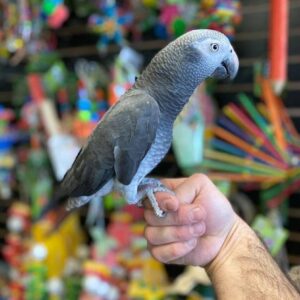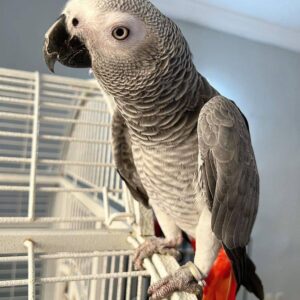Sale!
Baby African Grey Congo Parrot
Rated 5.00 out of 5 based on 6 customer ratings
(6 customer reviews)
$800.00 Original price was: $800.00.$400.00Current price is: $400.00.
Tame, young, talking Baby African Grey Congo Parrot for sale. 6 Months old male and female. For them to develop their full potential they have a huge aviary to learn how to fly and navigate well. This is very important for brain development, muscle tone, heart health, lungs, etc. They should always have access to lots of swings and toys. They will come with free toys and a manual on how to take care of a parrot / raise a baby parrot.
Categories: African Grey Parrot For Sale, Parrot For Sale
Tags: african gray parrot for sale las vegas, african grey bird 4 sale, AFRICAN GREY PARROT BREEDER, african grey parrot breeders in virginia, african grey parrot breeding pair for sale, african grey parrot breeding pair for sale uk, african grey parrot cages for sale near me, african grey parrot cages for sale uk, african grey parrot eggs for sale in usa, african grey parrot eggs for sale near me, african grey parrot for sale $200, african grey parrot for sale 1 leg, african grey parrot for sale 1 week old, african grey parrot for sale 1 year old, african grey parrot for sale 10 year old, african grey parrot for sale 1000, african grey parrot for sale 11 week old, african grey parrot for sale 12 week old, african grey parrot for sale 12 year old, african grey parrot for sale 3 months old, african grey parrot for sale 3 week old, african grey parrot for sale 3 year old, african grey parrot for sale 30 year old, african grey parrot for sale 3d, african grey parrot for sale 3d model, african grey parrot for sale 5 month old, african grey parrot for sale 5 week old, african grey parrot for sale 5 weeks, african grey parrot for sale 5 year old, african grey parrot for sale 50 lbs, african grey parrot for sale 5000, african grey parrot for sale 6 months old, african grey parrot for sale 6 week old, african grey parrot for sale 7 month old, african grey parrot for sale 7 year old, african grey parrot for sale 8 month old, african grey parrot for sale 8 week old, african grey parrot for sale austin tx, african grey parrot for sale in east yorkshire, african grey parrot for sale in islamabad olx, african grey parrot for sale in kansas, african grey parrot for sale in karachi, african grey parrot for sale in kentucky, african grey parrot for sale in kerala, african grey parrot for sale in kuwait, african grey parrot for sale in memphis tn, african grey parrot for sale in pakistan, african grey parrot for sale in puerto rico, african grey parrot for sale in qatar, african grey parrot for sale in reading, african grey parrot for sale in riverside ca, african grey parrot for sale in riyadh, african grey parrot for sale in uae, african grey parrot for sale in utah, african grey parrot for sale in vadodara, african grey parrot for sale in wichita ks, african grey parrot for sale kent, african grey parrot for sale kentucky, african grey parrot for sale kerala, african grey parrot for sale kijiji, african grey parrot for sale klerksdorp, african grey parrot for sale lahore, african grey parrot for sale lancashire, african grey parrot for sale leeds, african grey parrot for sale leicester, african grey parrot for sale liverpool, african grey parrot for sale london, african grey parrot for sale louisiana, african grey parrot for sale louisville ky, african grey parrot for sale malta, african grey parrot for sale manchester, african grey parrot for sale maryland, african grey parrot for sale massachusetts, african grey parrot for sale melbourne, african grey parrot for sale miami, african grey parrot for sale michigan, african grey parrot for sale middlesbrough, african grey parrot for sale minnesota, african grey parrot for sale missouri, african grey parrot for sale montreal, african grey parrot for sale nc, african grey parrot for sale new york, african grey parrot for sale newcastle, african grey parrot for sale newcastle upon tyne, african grey parrot for sale norfolk, african grey parrot for sale north west, african grey parrot for sale north yorkshire, african grey parrot for sale nottingham, african grey parrot for sale nsw, african grey parrot for sale ny, african grey parrot for sale nyc, african grey parrot for sale nz, african grey parrot for sale oklahoma, african grey parrot for sale olx, african grey parrot for sale omaha ne, african grey parrot for sale on craigslist, african grey parrot for sale ontario, african grey parrot for sale oregon, african grey parrot for sale orlando, african grey parrot for sale oxfordshire, african grey parrot for sale pakistan, african grey parrot for sale perth, african grey parrot for sale perth wa, african grey parrot for sale pets4homes, african grey parrot for sale philippines, african grey parrot for sale phoenix, african grey parrot for sale plymouth, african grey parrot for sale portland oregon, african grey parrot for sale portsmouth, african grey parrot for sale pretoria, african grey parrot for sale price, african grey parrot for sale qld, african grey parrot for sale quebec, african grey parrot for sale queensland, african grey parrot for sale rochester ny, african grey parrot for sale sacramento, african grey parrot for sale san antonio, african grey parrot for sale saskatchewan, african grey parrot for sale scotland, african grey parrot for sale seattle, african grey parrot for sale singapore, african grey parrot for sale somerset, african grey parrot for sale south africa, african grey parrot for sale south wales, african grey parrot for sale south yorkshire, african grey parrot for sale southampton, african grey parrot for sale sydney, african grey parrot for sale tampa, african grey parrot for sale tasmania, african grey parrot for sale telford, african grey parrot for sale texas, african grey parrot for sale thailand, african grey parrot for sale toronto, african grey parrot for sale torquay, african grey parrot for sale uae, african grey parrot for sale uk, african grey parrot for sale uk gumtree, african grey parrot for sale usa, african grey parrot for sale utah, african grey parrot for sale vancouver, african grey parrot for sale victoria, african grey parrot for sale virginia, african grey parrot for sale wales, african grey parrot for sale walsall, african grey parrot for sale washington state, african grey parrot for sale west midlands, african grey parrot for sale west sussex, african grey parrot for sale west yorkshire, african grey parrot for sale wigan, african grey parrot for sale winnipeg, african grey parrot for sale wirral, african grey parrot for sale wisconsin, african grey parrot for sale xenia ohio, african grey parrot for sale xxl, african grey parrot for sale yorkshire, African Grey Parrot Pair For Sale, african grey parrot pet for sale, african grey parrot price in canada, african grey parrot price in ghana, african grey parrot price in qatar, african grey parrot price range, AFRICAN GREY PARROT WANTED, African Grey Parrots, african grey parrots for sale birmingham uk, african grey parrots for sale in new zealand, african grey parrots for sale in west virginia, african grey parrots for sale kzn, african grey parrots for sale tennessee, african grey red tail parrot for sale, baby african grey parrot for sale, BABY AFRICAN GREY PARROT FOR SALE NEAR ME, baby african grey parrot for sale west yorkshire, buy african grey parrot, buy timneh african grey parrot, Congo African nuri kelabu untuk dijual, CONGO BABY AFRICAN GREY PARROT FOR SALE, Eclectus papegaai te koop, how to buy a african grey parrot, https://greenwingmacawparrot.com/product/6-months-old-african-grey-parrot-for-sale/, Kongo Graupapagei zu verkaufen, live african grey parrot for sale, LOOKING FOR AFRICAN GREY PARROT, macaw african grey parrot for sale, newborn african grey parrot for sale, old african grey parrot for sale, olx african grey parrot for sale, online african grey parrot for sale, Pappagallo africano grigio Congo, parrot african grey price, Parrots For Sale, perroquet eclectus à vendre, real african grey parrot for sale, red african grey parrot for sale, rescue african grey parrot for sale, south african grey parrot for sale, TALKATIVE AFRICAN GREY PARROT FOR SALE, tame african grey parrot for sale, the african grey parrot for sale, timneh african grey parrot for sale, wild african grey parrot for sale, young african grey parrot for sale
Related products
-
Sale!

Baby African Grey Timneh Parrot
$500.00Original price was: $500.00.$250.00Current price is: $250.00. Add to cart -
Sale!

Bella – Congo African Grey
Rated 5.00 out of 5$1,000.00Original price was: $1,000.00.$400.00Current price is: $400.00. Add to cart -
Sale!

African Grey Parrot Pair
$1,900.00Original price was: $1,900.00.$700.00Current price is: $700.00. Add to cart

j5suo –
Thank you. My kids are so happy. Thank you again for not letting us down
jade –
I love it so much I finally found a good bird for less.
Vicktoria –
I received my parrot this morning. He is just jumping around and saying “you” all hour long when approached. Thank you so much
Eric –
You sent me a female parrot instead of a male. But it’s still ok. Please next time be don’t let this happen to another customer. You might get a bad review for that even though you said it was a mistake. She keeps trying to bite my wife and refuses to go into her cage. Will only stay on my lap or hang on my trousers when I’m moving
Josselyn –
Really good
mikey –
is it real